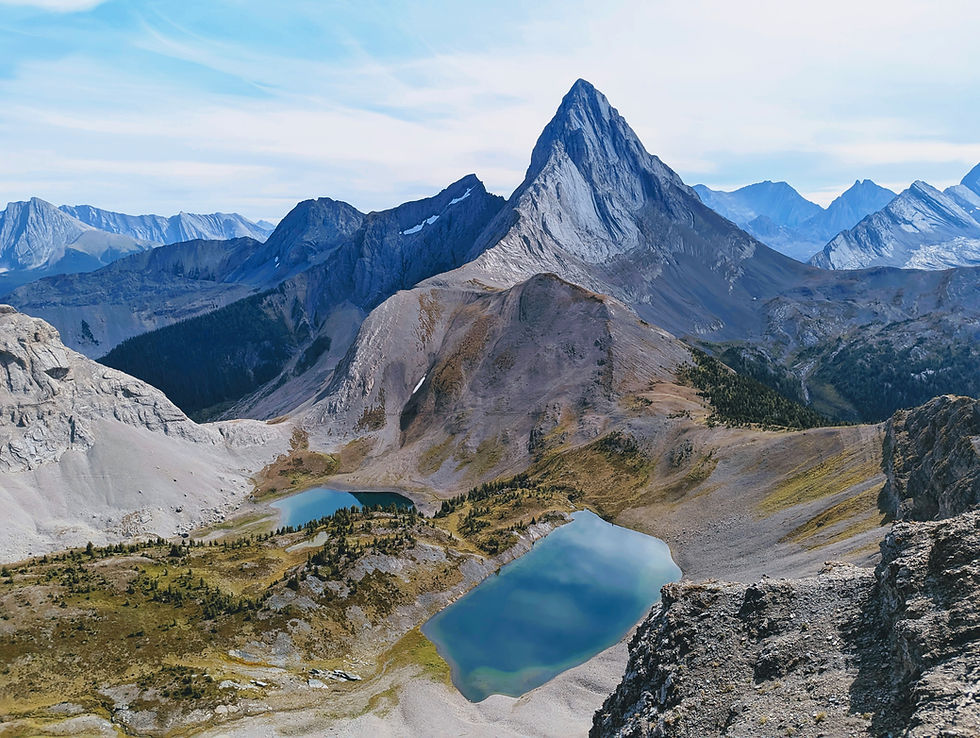The Story Behind the Turquoise Colour of the Lakes
- Keith Fernandes
- Aug 22
- 3 min read
By now everyone’s seen the photos: Moraine Lake with its distinctive azure-blue, Lake Louise and her famous turquoise-green, and Peyto’s wolf-shaped brilliant aquamarine. The colours look unreal, like someone boosted the saturation just a little too far and honestly, they look even more incredible in person. We often get asked why these lakes look the way the do, and the true story of that colouur is a mix of glaciers, sunlight, and timing. The best part is that by timing your visit right, you can catch them at their peak!

It Starts with the Glaciers
The secret ingredient is “rock flour.” Over time, glaciers grind down the mountains beneath them into a fine powder, and when that powder washes into the lakes with meltwater, it stays suspended in the water. These suspended mineral solids refract the sunlight and create those famous shades of blue and green.
Why Timing Matters
Here’s the trick: the colouur changes through the season. Early spring, many lakes are still frozen or just starting to thaw, so the water can look gray, dark, or even a little murky. By mid-to-late June, as the snowpack and glaciers really start melting, the rock flour content ramps up and the colours come alive. July and August are usually peak season for the most vibrant turquoise. By fall, as temperatures drop and the flow of meltwater slows, lakes can start to lose a bit of that punch.
Lake by Lake
Moraine Lake: At its brightest late June through early September. It can look duller in May, when the lake is first thawing out, and access is often closed until then anyway.
Lake Louise: Holds its turquoise-green glow a little longer into fall, thanks to steady glacial inflow.
Peyto Lake: One of the most dramatic shifts, pale and icy in early spring, glowing aquamarine midsummer.
Emerald Lake: True to its name, this one leans more green than blue, and the colour is gorgeous on cloudy days too.
Sunrise and Sunset: The Honest Truth
A lot of folks plan their trip around sunrise at Moraine Lake because that’s what the Instagram algorithm pushed them to do. Here’s the thing: if you’re chasing that famous turquoise, sunrise is actually one of the worst times to go. The lake sits in a deep valley with the Ten Peaks to the east, so at dawn it’s almost entirely in shadow. Instead of glowing blue, the water looks dark, even muddy.
Sunset isn’t much better. The warm evening light is beautiful for the peaks, but it softens or even dulls the colour of the water. The lakes pop the most when the sun is high overhead, late morning through early afternoon is when you’ll see them at their most electric.
That’s not to say sunrise or sunset aren’t worth it. Sunrise mist curling across Lake Louise, or alpenglow lighting up the Ten Peaks above Moraine, can still be unforgettable. But if your goal is that jaw-dropping turquoise, skip the 4 a.m. wake-up call and go when the sun’s got some height.
A Living, Changing Landscape
One last note: these colours aren’t guaranteed forever. If a glacier feeding a lake shrinks away completely, the supply of rock flour slows down and eventually the colour fades. Every visit is a little snapshot in time, and part of what makes these lakes so special.



_edited_p.png)
Comments